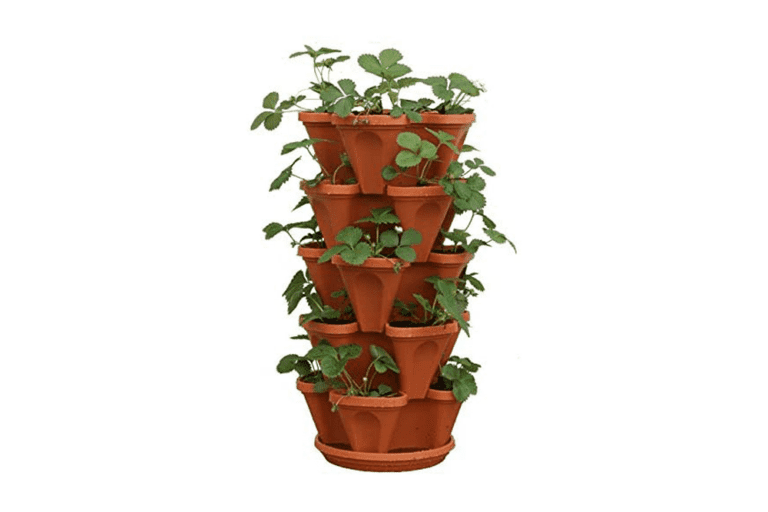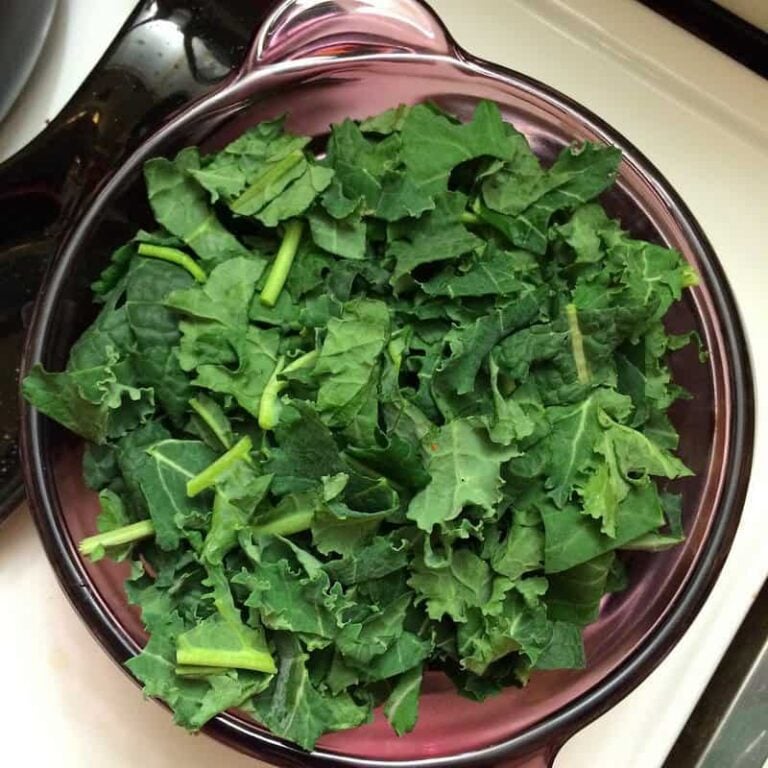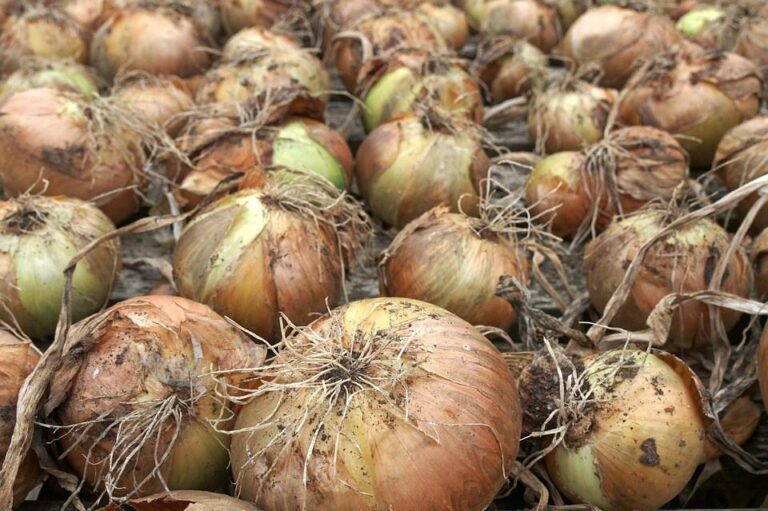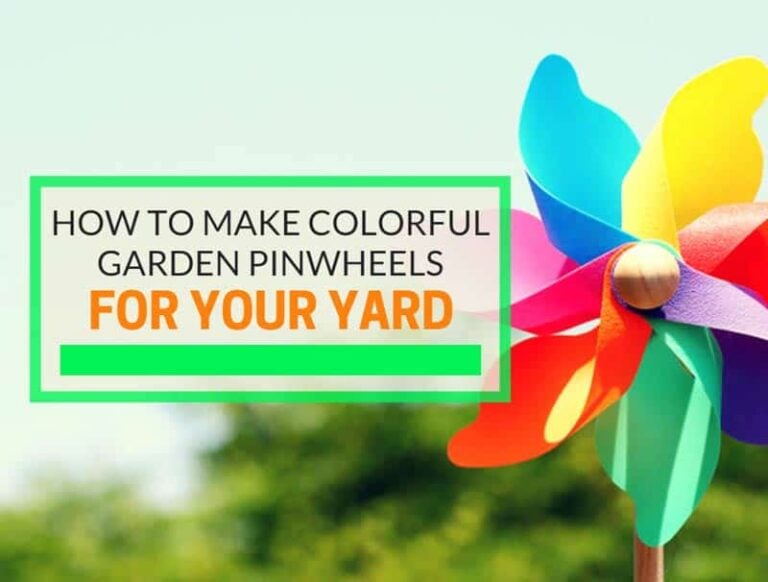When To Harvest Onions
From all the vegetables one can grow, onions are among the most popular. And it is easy to understand why.
Onions come in many varieties, they can be consumed both green and mature and, above all, are essential ingredients for many dishes.
Just like for many other veggies, the main question one asks when growing onions for the first time is: when to harvest onions? The answer is as simple as the exquisite veggie we’re talking about.
When To Harvest Onions
The part I like best about onions is that they are ready for harvest from as soon as their green tops come out of the ground. Nevertheless, if you want to eat a tasty green onion I would suggest waiting for the first harvest until the leaves of the plant reach about 6 inches in height.
While it is true that green onions are refreshing and tasty, it is also true that many recipes require the use of mature onions. On the other hand, many gardeners, including myself, love to have a substantial crop of mature onions ready to harvest at the end of the summer.

To know when to harvest mature onions, the best thing to do is to observe the green tops. As soon as you notice that the leaves start to turn brown and the tops tend to fall, it is time to harvest. This will usually happen after about 100 – 120 days after seeding.
At this stage, hold your horses and wait until 80 or 90% of your crop has fallen, brownish leaves. After you have noticed that almost all of your onions stopped growing, leave them in the ground to mature for another week to ten days. This will define the final taste and will make the bulbs more prone for storage.
However, it is not recommended to leave the onions to mature in the ground for more than 10 days. There are two reasons why you wouldn’t want to wait longer. The first one is that the bulb might start growing a new onion plant. In this way, the bulb will lose some of its properties and will not store well.
Secondly, your delicious onions might develop bacteria or become subject to organisms that can cause them to rot early.
After these days have passed, it is time to pick the onions, ideally on a sunny day so you can leave them to dry in the sun for a few hours or for a day or two.
The theory above is simple to understand, but if you live in a colder climate and if you are unlucky enough to grow your first onions in a rainy season, how to tell when to harvest onions?
The confusion might be caused by the fact that the green tops of the plant will most likely not flop over and will stay green for a longer time.
In this case, after about 100 days after planting, you can check if the onions are mature by squeezing the stalk at about 2-3 inches above the bulb. If you notice a soft spot it means that the onions stopped growing and you should harvest as soon as possible.
An alternative way to check if your onions are ready to harvest is to pull up one onion and measure its diameter. For most onions, you should look for a diameter between three and five inches. The packaging should offer the necessary information or you could just look up for the mature size of the variety of onions you grow.
If the season is rainy, or if there is predicted a heavy rain, you should harvest the onions as soon as you notice the ripen signs described above, without leaving the bulbs to mature further. Excessive moist damages the onion bulbs and they might not store well.
If some of your onions grew long stalks and developed flowers, you might want to discard them. They will most likely not store well and the taste might also be altered. You could use the seeds from the flowers to sow your future crops.
If possible, choose a sunny day to harvest your onions. The best time to harvest is early in the morning, especially if you live in a hot climate.
How To Harvest Onions
Harvesting onions is extremely simple, but the process is rather delicate, so you will have to pay special attention to not damage the bulbs.
To harvest onions, gently pull or dig the bulbs from the ground, leaving their tops attached. Shake them gently to remove excess dirt then leave the bulbs outdoors for a day or two to dry in the sun. Obviously, if the season is rainy you will have to skip the drying step.
After the onions dried for a couple of days, it is time to pass to the curing stage. Curing is essential if you want the bulbs to store well throughout the winter.
How To Cure Onions
As mentioned above, curing is essential for the good preservation of your onions. At this stage, some experts advise to trim the tops of the onions and cure the bulbs alone. Even if trimming the tops is not really necessary, if you feel like doing so, pay attention to leave at least one inch of leaves above the bulb.
If you completely cut the leaves, the neck of the bulb will not dry well and might cause early rotting.
To cure the onions, choose a warm, shaded and airy place, such as a porch or a shaded terrace and arrange your onions in a single layer, leaving a couple of inches of space between the bulbs. If you don’t have a shady spot where to place the bulbs, you can leave them in your garden and cover them with a thin cotton sheet to keep them away from the sunlight.
If you do this, pay attention to use exclusively a cotton sheet to cover your bulbs. Synthetic fabrics, together with plastic foils, don’t allow a proper air flow and will not let the onions to dry. If the onions are not completely dry when you put them into storage, they might rot.
To promote drying, you should rotate the bulbs for a few times every day. As the onions will dry out, you will notice that their roots will become wiry, while the skins will rattle. As soon as you notice these signs, check each bulb for any wet spots.
If the onions are completely dry, you have two possibilities. If you didn’t trim the leaves, you can make one or more onion braids and hang them in an airy place for some further drying before moving them to storage.
If you trimmed the leaves, then you should put the onions is mesh bags and hang them in an airy spot for further drying. In both cases, the place you choose should be warm and shaded.
To cure the onions well, you will probably need two or three weeks. Don’t hurry to get the onions in the storage as quickly as possible. In fact, the longer you cure them the better they will keep.
How To Store Onions
If you have a basement or a cellar, you should know that the onions store well at temperatures between 40 and 50°F. If the temperature is higher, you might notice that your onions start to sprout and they will not be fit for consumption anymore. Excessive cold, on the other hand, can cause them to rot.
The place should also be properly ventilated, or humidity might damage your onions. As a general rule, the humidity level should not exceed 70%.
If you decide to store the onions in mesh bags, tie a knot between each onion to keep them at a distance from each other. This will ensure a better airflow and the onions will keep longer.
If you don’t have a cool and dark place where to store the onions, you might want to consider freezing them. You can freeze:
- Whole onions: peel them off and leave them in warm water for about five minutes. Cool and dry the onions then put them on oven sheets in the freezer. As soon as they are frozen, transfer them into freezer bags for long term storage.
- Chopped onions: chop the onions as fine as you like and spread them on an oven sheet. Cover them with a second oven sheet and freeze them for about one hour. Transfer the chopped onions to freezer bags and put them into the freezer again. If you want, you can portion them for easier use.
- Onions puree: make the onion puree by blending the onions until smooth. Transfer the puree into ice cube trays and cover with a freezer bag, then freeze the onions.
Final Thoughts
Now, you not only know when to harvest onions but you also know how to cure and store them.
What is your favorite onions variety? And how do you store your onions? Leave a comment below with any questions or tips.





